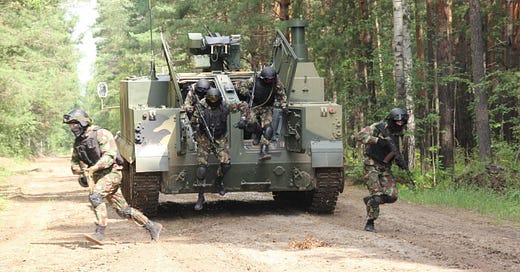Russia's Newest Armored Vehicle Is So Bad That One Russian Would Prefer to Ride Into Battle in a Golf Cart
The BT-3F is just a 'target' for drones and mines
After years of development, Russian vehicle-maker Rostec has finally begun operational testing of the new BT-3F armored personnel carrier. It might not be long before the 19-ton, 17-person APC shows up in Ukraine.
Some Russian military bloggers hope it never does. The BT-3F may be new, but it’s not new enough to reflect the Russians’ hard experience in Ukraine. The vehicle is vulnerable to mines and drones and its best quality—its amphibious capability—is next to useless in the current war.
The turretless BT-3F is so bad that one blogger would prefer to ride into battle on a motorcycle or in a golf cart, which are equally vulnerable but are at least agile—something the tracked BT-3F isn’t.
“A high-speed vehicle still has at least some chance of transferring troops to the other side in front-line conditions,” blogger Ramzai wrote, “but a slow-moving, multi-ton vehicle is practically doomed.”
“It’s a target!” Ramzai added. “And as a result, a logical question arises: why does the army need a vehicle worth millions of rubles, which has become hopelessly outdated before it has even entered service?”
The answer, of course, is that the Russian armed forces are desperate for any and all vehicles—and Russian acquisitions officials don’t always make the best decisions, even when the stakes are so enormous.
Having lost 17,000 armored vehicles and other heavy equipment in 39 months of hard fighting in Ukraine, the Russians are running so low on purpose-made combat vehicles that civilian cars, trucks, bikes and even scooters now account for 90 percent of battlefield losses.
The stress resulting from the Russian military’s de-mechanization should be clarifying for the Kremlin. Instead, that stress may be exacerbating the bureaucratic dysfunction that’s so typical of peacetime. The Kremlin might be in such a rush to field new armored vehicles that it will shove money at any program that’s nearly ready for full-rate production.
A BMP minus the turret
The BT-3F borrows the hull of a BMP-3 infantry fighting vehicle but omits the turret with its 30-millimeter autocannon in favor of a smaller remote mount for a 12.7-millimeter machine gun. “This armored vehicle is designed to transport motorized infantry or specialized troops; it can also serve as a tactical command center or a medical service vehicle,” Rostec stated.
But the vehicle was designed years before the wider war in Ukraine—before super-dense minefields and swarms of tiny drones changed how mechanized forces fight.
“The low track base is extremely vulnerable to detonation” from below, Ramzai wrote about the BT-3F. The top-mounted passenger door, which Ramzai likened to '“cardboard,” could be prone to jamming and “turns the troop compartment into a saucepan” whenever an explosive drone strikes from above.
As for the vehicles buoyancy, “this advantage in the era of UAV air supremacy is more questionable than real.”
It could be a while before the new APC passes it tests. “The equipment must confirm the specified tactical and technical characteristics on land and in water in various climatic zones, as well as pass firing tests from a standstill, on the move and afloat,” Rostec stated.
And it’s unclear how many, if any, BT-3Fs the Kremlin will order once all this testing is complete. Russian troops should hope for none. Ukrainian troops should hope for lots.
Smart Kremlin planners might cancel the BT-3F and spend its procurement budget on fast armored trucks with high wheels, all-around blast-protection and rear doors for rapid mounting and dismounting.
But planners aren’t always smart or motivated by the needs of front-line forces; this truism applies to the Kremlin, the Pentagon and all other national military headquarters. Corruption, the sunk-cost fallacy and sheer bureaucratic inertia have ways of carrying bad weapons through development to deployment.
Even during wartime. Perhaps especially during wartime, when money may be plentiful and oversight lacking.
The BT-3F program’s progress is dispiriting for rank-and-file Russians. “Is this really all that the domestic design thought has created in three years of the [special military operation]?” Ramzai asked.
Tragically for the troops who may end up riding in the BT-3F in Ukraine, the answer appears to be yes.
Read more:
Russia Tests New 'Porcupine' Anti-Drone Armor. Ukraine's Drones Still Win.
Two years ago, Russian troops began wrapping their armored vehicles in shell-like layers of add-on armor—all in a desperate effort to protect the vehicles from Ukrainian drones. The Ukrainians gave these up-armored vehicles a name—“turtle tank”—and got to work destroying them with better-aimed and more powerful drones.






